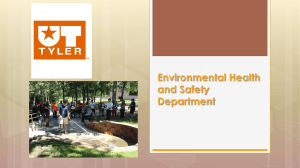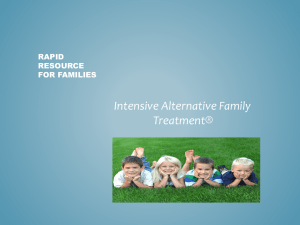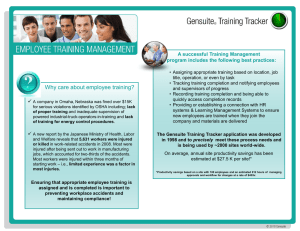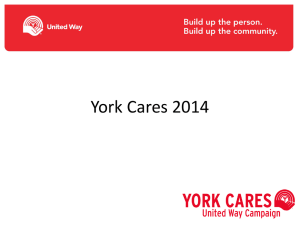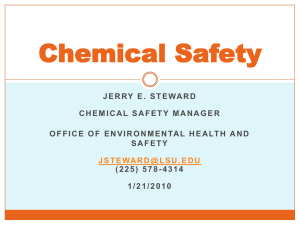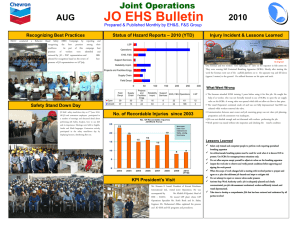Zobel_FarrisPresenta..
advertisement
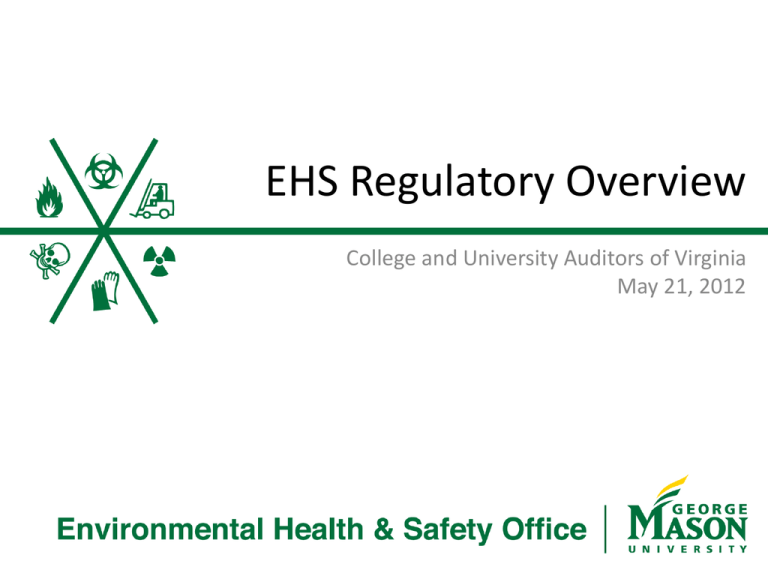
EHS Regulatory Overview College and University Auditors of Virginia May 21, 2012 EHS Functions • Environmental Health & Safety – Environmental Compliance – Emergency Preparedness & Response – Fire Safety – Laboratory Safety – Occupational Health – Occupational Safety EHS Mission • EHS partners with various University officials, departments, and personnel to promote health, safety, environmental protection, emergency preparedness and compliance with applicable local, state, and federal regulations, guidelines, and best practices. Requirements Framework • • • • • • Laws & Regulations Executive Orders Guidelines Industry Standards Best Practices University Policies Occupational Safety Requirements Framework • OSHA State Plan States • OSHA/VOSH: Workplace Safety & Health – – – – – Bloodborne Pathogens Hazard Communications Walking and Working Surfaces Personal Protective Equipment and MANY more - Confined Spaces - Electrical Safety - Fall Protection • DHRM: Workers’ Compensation • NFPA/NEC: Electrical Safety Occupational Health Requirements Framework • CDC/NIOSH: – Respiratory Protection, Medical Surveillance • NIH/OLAW: Animal Care Workers • AAALAC /NRC: – Animal Care Workers, Vivarium Facilities • ACGIH: – Chemical Exposure Limits, Noise, Temperature Extremes • ANSI: Lab Ventilation • ASHRAE: Ventilation • EPA: Indoor Air Quality Laboratory Safety Requirements Framework • OSHA/VOSH: Laboratory Safety and Chemical Hygiene, • • • • • • • • Laboratory Amenities/Equipment, Laboratory Safety Practices NRC/VDH: Radiation Safety Practices and Licensing CDC: Registration of Select Agents NIH: Biosafety Practices, Facilities, and Project Review DEA: Controlled Substances DOT: Hazardous Materials Transportation Security, Domestic Hazardous Materials Shipping IATA: International Shipping and Shipments by Air DHS: Chemical Facility Security ANSI: SEW, Lab Decommissioning Environmental Compliance Requirements Framework • EPA/DEQ: – Air Emissions – Hazardous Materials & Waste – Spill Prevention and Controls – Pesticide Application – Storm Water Pollution Prevention – AST and UST • Local POTW Fire Safety Requirements Framework • IFC/VaSWFPC: – Fire Prevention – Fire Suppression Systems • IBC • NFPA: – Specific Codes as Adopted by VaSWFPC • DoEd: – Fire Statistics in Residence Halls Emergency Preparedness Requirements Framework • FEMA/VDEM: – Emergency Plans and Procedures, Emergency Preparedness Guidance • Office of the Governor (Executive Order 41): – Emergency Preparedness via EOP • DoEd: – Missing Students, Timely Emergency Notification Overarching Requirements • OSHA General Duty Clause requires an employer to furnish to its employees: "employment and a place of employment which are free from recognized hazards that are causing or are likely to cause death or serious physical harm to his employees..." Overarching Requirements • NIH Grants Policy Statement “Grantees are responsible for meeting applicable Federal, State, and local health and safety standards and for establishing and implementing necessary measures to minimize their employees' risk of injury or illness in activities related to NIH grants.” Risks • • • • • • • Injury or Illness Loss of Accreditation Decrease in Grant Funding Regulatory Fines Reputation Damage Property Damage Delay New Academic Programs/Research or New Facilities Successful Implementation • • • • • • Buy In Structure Outreach/Communication Education & Training Review & Monitoring Customer Service Oriented Staff EHS Services Provided – Building Evacuation Plans – University & Unit Level Emergency Planning – Ergonomic Assessments – Exposure Monitoring – Fire Cause Investigation – Fire Drills – Fire Extinguishers: Installation, Inspection, and Testing – Fire Protection Systems: Inspection and Testing – Hazardous Materials Shipping – – – – – – – – – High Hazard Area Inspections Indoor Air Quality Investigations Laboratory Project Review Laboratory Signage Mason Alert Emergency Messaging Medical Surveillance Personal Protective Equipment Selection Training, Workshop, Emergency Exercises Waste Pickups and Waste Container Distribution Fire Safety Overview of Regulations • • • • Virginia Statewide Fire Prevention Code NFPA sections by adoption International Fire Code (IFC) International Building Code (IBC) Systems Inspections / Testing Fire Suppression Equipment Inspection Frequency Inspection Frequency Equipment: Weekly Portable Fire Extinguisher: Monthly Quarterly Annually X Responsible Party EHS Smoke Alarm: X Contractor Fire Alarm: X Contractor Fire Pump Inspection: X EHS Fire Pump Test: FDC and PIV: X X Contractor EHS FDC and PIV: X Contractor Sprinkler System: X Contractor Evacuation Route Signage: X EHS Enunciator Panel: X Contractor Fire Safety Plan: X EHS Building Inspection: X EHS Unique Equipment: Case by Case Basis EHS Systems Inspections / Testing Equipment: A Back Flow Preventer Monthly Building Inspection Quarterly* Check Valve Fire Safety Programs Inspection/Cleaning Frequency Resp. B E R-2 Party Monthly Monthly Monthly EHS SemiAnnually* Annually EHS/SFM Annually * Testing/Certification Frequency A B E R-2 Resp. Party Annually Annually Annually Annually EHS/FM NA NA NA NA NA ? ? ? ? ? ? ? ? ? ? Weekly Weekly Weekly Weekly EHS Quarterly Quarterly Quarterly Quarterly EHS Monthly Monthly Monthly Monthly EHS Quarterly Quarterly Quarterly Quarterly EHS Elevator Hoistway NA NA NA NA NA Annually Annually Annually Annually EHS/C Emergency Exit Signs NA NA NA NA NA Monthly Monthly Monthly Quarterly Quarterly EHS NA NA NA Quarterly Quarterly Quarterly Quarterly EHS Control Valves (sealed nonmonitored)! Control Valves (locked or tampered) Evacuation/Shelt Quarterly er Training*** Fire Department Connection Fire Alarm System Weekly NA Weekly Weekly Weekly Monthly Occupants NA NA Five Years Five Years Five Years Five Years EHS/FD FM-FAS Annually Annually Annually Annually EHS/C Systems Inspections / Testing Equipment: A Fire Safety Programs Inspection/Cleaning Frequency Resp. B E R-2 Party A Testing/Certification Frequency B E R-2 Resp. Party NA NA NA NA Fire Drills Quarterly Annually Monthly Quarterly EHS Fire Extinguishers Monthly Monthly Monthly Monthly EHS Annually Annually Annually Annually EHS Fire Pump^ Weekly EHS Annually Annually Annually Annually EHS/C EHS/C SemiSemiSemiSemiAnnually Annually Annually Annually EHS/C EHS Annually Annually Annually Annually EHS/C/F D Hood System Cleaning**** Stand Pipes# Weekly Weekly Weekly Annually Annually Annually Annually Weekly Weekly Weekly Weekly NA PIV (include in Monthly Monthly Monthly Monthly EHS Quarterly Quarterly Quarterly Quarterly EHS control valve) Smoke Detector NA Weekly NA Weekly Occupants Annually Annually Annually Annually EHS (battery) Automatic Fire SemiSemiSemiSemiDoors/Curtains/ FM Annually Annually Annually Annually FM Annually Annually Annually Annually Rollup Smoke Evac System (nonWeekly Weekly Weekly Weekly Annually Annually Annually Annually dedicated) Smoke Evac SemiSemiSemiSemiSystem Weekly Weekly Weekly Weekly Annually Annually Annually Annually (dedicated) Sprinkler Annually Annually Annually Annually EHS Quarterly Quarterly Quarterly Quarterly EHS/C System Inspection Records Systems Inspections Systems Inspections Fire Drills Annual Fire Drills • Based on occupancy • Must be documented Group or Occupancy Assembly Buildings Group A Educational / Business Group B Adult and Child Care Group E Hotels Group R-1 Residence Halls Group R-2 Frequency Examples Quarterly Patriot Center, Center for the Arts, Johnson Center Annually Innovation Hall, Research I, Thompson Hall Monthly Child Development Center Quarterly Each Shift The Mason Inn Four Annually Northern Neck, Commonwealth Hall, Wilson Hall Other Compliance Issues Issue Frequency Tent Permits Occasionally Hotwork Permits Weekly Pyrotechnics Rarely Special Events Occasionally Building Fire Evacuation Plans Ongoing Fire Safety Plans Ongoing Emergency Key Inventory and Supply Ongoing Knox Box Occasionally Emergency Planning/Walk-throughs Occasionally Challenges • Record keeping – Electronic vs. hard copy – Records retention period – Access – Periodic audits • Having enough personnel to complete work – Growth of the University – Adding additional inspections and testing to schedule Emergency Preparedness Executive Order 41 – 9/30/11 • Appointment of Emergency Coordination Officer (ECO) and alternate. • Must maintain and test specific plans • Mandatory training (within 90 days of employment) 1. DHRM-HR Policy – Preventing Workplace Violence 2. Terrorism and Security Awareness Orientation 3. ISC 100.b, 700.a, and 800 (for ECO and “other appropriate personnel” “Include emergency preparedness in its strategic planning and performance management process” Promote a “culture of preparedness” Continuity of Operations Plan • • • • • • • Required to meet VDEM guidelines/content Updated annually Brief applicable personnel with 60 days of hire Conduct training for leadership and key personnel Maintain a roster of key agency personnel Conduct an annual test or exercise with AAR Submit to VDEM April 1st for review Annual Preparedness Assessment • Each agency must respond to a state preparedness assessment by Oct. 31st • Given a grade that is reported on a letter to the College or University President Emergency Action Plan • • • • Requirement for all colleges and universities Board of Visitors must formally adopt the plan Plan must be reviewed every four years President and Vice President must annually – Review the plan – Certify in writing that the plan has been reviewed – Make recommendations to the plan as necessary • Conduct a functional exercise!!! Questions? Julie Zobel Assistant Vice President, EHS jzobel@gmu.edu (703) 993-8630 David Farris Director of Emergency Preparedness and Response dfarris@gmu.edu (703) 993-2507 Environmental Health and Safety Office ehs.gmu.edu

